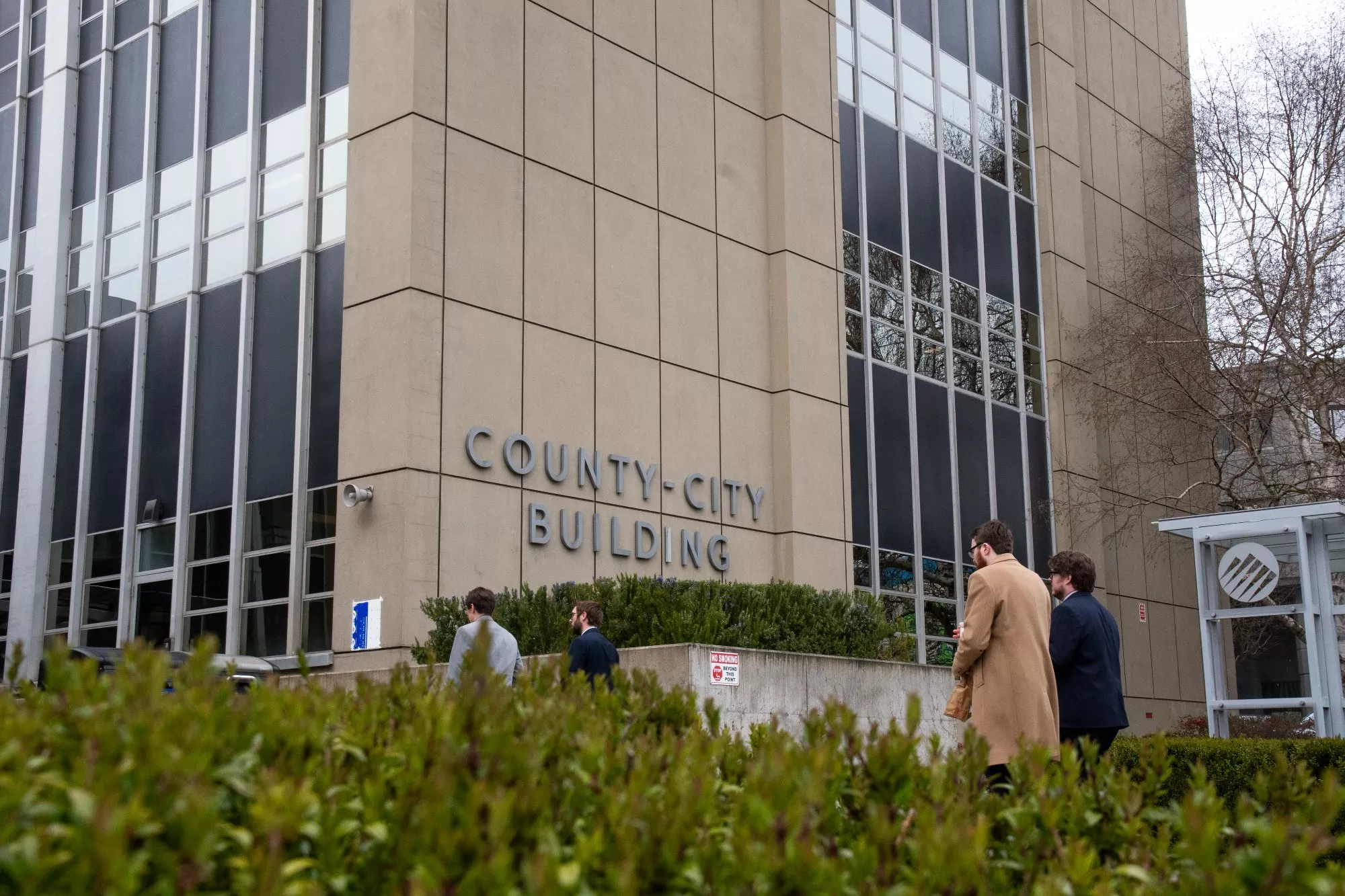Pierce County violated state law by diverting millions in tax revenue meant to improve 911 calls, state audit finds
Officials repeatedly ignored guidance regarding their $4.5 million purchase to boost law enforcement radio connection at a government building in Tacoma, jeopardizing federal funding

When a resident of Pierce County calls 911, their call is routed to the regional call center in Tacoma, which handles nearly 1 million calls each year and works as the communication bridge for the county’s 39 local police and fire agencies.
The center’s operations rely on funds collected through a special excise tax charged monthly to all phone lines. Under state law, revenues from the tax are meant to support the overall operations and maintenance of the public safety answering point, aka the 911 center, which can include such things as improving the technology that identifies a caller’s precise location, and ensuring that the person answering the emergency call is properly paid and supported. The funds are not meant to support the second half of the 911 system, which relates to law enforcement's response. The dedicated funding stream is critical, especially since 911 call centers across the country have long faced funding struggles, resulting in inadequate or outdated technology, high levels of staff turnover and burnout, and delays in emergency response, which can have deadly consequences.
But in 2022, Pierce County officials used $4.5 million from the restricted tax revenue fund –– more than 75% of the taxes collected that year –– to install technology at a government building in Tacoma related to the local public safety radio system, a move that state auditors say violates state law and puts federal 911 funding at risk for the rest of the state. Public records obtained by InvestigateWest show county officials repeatedly ignored warnings that they were misusing funds, and that it wasn’t the first time they had diverted 911 funds for unapproved purposes and stood by their decision.
“We respectfully disagree with the audit finding, and we provided information about our position in that audit response,” said Arel Solie, Pierce County’s director of the Department of Emergency Management. The noncompliance issues were presented to members of Pierce County's executive office, County Council members and department leadership during a meeting with state auditors on May 28. A representative for the executive office or County Council was not made available for an interview.
The accountability audit, published in June by the Office of the Washington State Auditor, centered on Pierce County’s installation of a distributed antenna system throughout a county building in 2022, which is home to a handful of government entities, most notably the Pierce County Sheriff’s Office and the county jail.
The county claims in a written response to auditors that it had met the obligations to invest locally in the enhanced 911 system. County officials said they used “surplus” funds designated for the “repair, upgrade, and replacement of equipment related to the County’s emergency services communication system,” which they believe includes the distributed antenna system installed at the jail. The antenna system amplifies the signal for hand-held radios used by law enforcement to enable better communication in and out of the government building.
Katy Myers, the chair of the statewide 911 Advisory Committee within the Washington State Military Department, said in her 30 years working in the field, a distributed antenna system or police radios have never been an allowable expense using 911 excise tax funds. The funds are meant to improve the first point of contact of an emergency call, which is the public safety answering point. In Pierce County, that’s the South Sound 911 center.
“The 911 state office says that's a different kettle of fish altogether,” said Myers, referring to the distributed antenna system. “It has nothing to do with people calling 911 and getting access.”
Myers, who is the deputy director at NORCOM, a consolidated 911 center that serves northeast King County, said it’s important that the funds are allocated appropriately, especially given how underfunded 911 centers across the state are to begin with.
“There are counties in this state that you would be sad to see the building that your 911 center is in,” Myers said. “It's in a trailer, basically, with no ceilings and no good ventilation.”
Records show it’s not the first time that Pierce County has used 911 excise tax funds to pay for unapproved things. In 2017 and 2018, Pierce County also used those tax funds to pay for an emergency management phone alert system and an emergency radio system, which were cited in an earlier state audit. The Washington State Legislature was also found to have misused 911 excise tax funds in 2013 when lawmakers approved $2 million to be used to buy radio equipment for the Department of Corrections, according to a legislative report.
Pierce County officials wrote to state auditors explaining the issue won’t happen again because they’ve since transferred ownership of the county’s 911 excise funds over to South Sound 911, but they still defended their previous use of the $4.5 million for the distributed antenna system, with no indication they plan on returning it.
But auditors reiterated that the funds should be returned to South Sound 911.

The less revenue collected through the 911 excise tax, the more partner agencies have to contribute to fund the 911 center, according to Julie Door, a Puyallup City Council member and the chair of the South Sound 911 Board of Directors.
“This money came out of the pockets of all of our partner agencies,” Door said, referring to the 39 first responder agencies that have their calls routed through South Sound 911. “That’s my concern with this.”
She added that the Federal Communications Commission is concerned about fee diversion and could pull funding.
“If we are not using it for its intended purpose,” Door said, “we risk federal dollars.”
Longstanding disagreement
Pierce County’s use of 911 excise tax funds has been debated for nearly a decade.
In 2016, Pierce County entered into an engineering and design contract with Motorola Solutions to design the distributed antenna system that would address a public safety radio communication “dead zone” in and around the government building in Tacoma, including the county jail.
In response, the cities of Tacoma, Lakewood, Fife and Puyallup, along with West Pierce Fire & Rescue, which all depend on the South Sound 911 call center as the entry point to their public safety communication systems, sent the county a letter criticizing the spending and requesting that those funds instead be turned over to the regional call center. The same entities reiterated their concerns in 2019.
“We believe that the intended purpose of the E911 excise tax is to directly support emergency communications, and that South Sound 911 is now the single unified local-government agency providing that service to the citizens of all of Pierce County,” they wrote. “This transfer would allow these revenues and this fund to meet its statutory basis and purpose.”
In Pierce County’s written response to state auditors, officials wrote they received guidance from the Washington State Military Department in 2018 stating that their proposed use of the funds was appropriate.
But later emails from the Military Department dispute those claims.
In August 2019, Adam Wasserman, the E911 coordinator with the state Military Department’s Emergency Management Division, stressed in an email to state auditors that the funds are meant for 911 calls, not for dispatching or communicating with first responders, according to meeting notes obtained by InvestigateWest.
“If counties use their excise tax funds to pay for dispatch and other services or equipment, there will be an even greater need for money to provide 911 equipment and personnel, without the necessary funds to meet the need,” Wasserman told state auditors.
In 2020, Wasserman reiterated many of those same points in a letter to 911 county coordinators across the state, then again in April 2021 directly to the Pierce County 911 coordinator.
“I am compelled to ensure that 911 fees are not being diverted or misused,” he wrote. “This diversion of 911 fees could result in Pierce County and possibly the state missing out on a significant federal grant opportunities if it is not rectified quickly.”
In response, Jody Ferguson, then-director of the Pierce County Department of Emergency Management, who retired in October 2024, wrote that her department “has consistently been a good steward of the E911 excise tax and has run an exemplary program.”
A few months later, the county issued the $4.5 million public works contract to Motorola Solutions to install the distributed antenna system throughout the city/county building. The company, which is largely known for its cellphones and police radios, has a growing presence in government surveillance and artificial intelligence and specializes in police body cameras, facial recognition technology and automated license plate readers.
The distributed antenna system primarily helps first responders radio in and out of the government building, including the jail. The technology gained popularity following the Sept. 11, 2001, attacks, when first responders had difficulty communicating with officers inside the World Trade Center. As the use of new energy-efficient materials has helped make buildings more environmentally friendly, those materials have also obstructed radio signals, Solie said.
Parts of the system are installed on the roof and throughout the Tacoma building, including within the county jail, where the control unit is located, according to Solie.
Solie, who has worked in emergency management for 22 years and started with the Pierce County department in April 2025, said any law enforcement agency operating within the building can use the technology.
Door, the Puyallup City Council member, doesn’t dispute Pierce County’s claims that improving radio connection within the jail was a public safety issue.
“But we have to be good stewards of the taxpayer dollars,” Door added.
The story you just read is only possible because readers like you support our mission to uncover truths that matter. If you value this reporting, help us continue producing high-impact investigations that drive real-world change. Your donation today ensures we can keep asking tough questions and bringing critical issues to light. Join us — because fearless, independent journalism depends on you!
— Jacob H. Fries, executive director
DonateCancel anytime.









